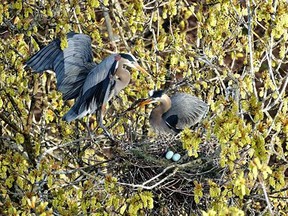Last year, the colony brought about 90 new heron chicks into the world, overcoming persistent eagle raids and a late nesting season

The Pacific great blue heron colony has returned to Stanley Park for a 23rd consecutive year.
In the trees surrounding the tennis courts, near the Vancouver park board head offices, a colony of 64 of the majestic herons has settled in to nest and raise a new generation of chicks.
Start planning for your weekend with expert recommendations from our team of writers on what to cook, where to dine, and the perfect wine pairing delivered straight to your inbox on Thursday at noon.
Thanks for signing up!
A welcome email is on its way. If you don't see it, please check your junk folder.
The next issue of West Coast Table will soon be in your inbox.
We encountered an issue signing you up. Please try again
“Last year, the colony brought approximately 90 new heron chicks into the world, overcoming persistent eagle raids and a late nesting season, due to more severe winter weather,” said the park board in an update on Monday.
Eighty per cent of B.C.’s heron population make the area in and around the Fraser River their home, so the Stanley Park colony “has significant implications for the viability of the whole subspecies.”
Fortunately, “this heron colony has proven to be above all else, resilient.”
The park board installed a heron cam eight years ago and, once again, bird watchers can take in the spectacle of the herons’ courtship and mating, nest building, egg laying and hatching this spring. The camera looks upon 40 nests, and viewers can take control of the camera to zoom in on multiple nests from different angles.
Those who visit the park are urged to give the herons space to nest and raise their chicks in peace. From mid-March to mid-July, that means watching the herons from outside fenced areas, avoiding loud noise or music within 30 metres of the colony, keeping dogs on leash, and avoiding the use of drones — which aren’t allowed in the park without a permit anyway.
If you see a fallen or injured chick, you can report it using the Van311 app or by calling 311. Do not try to handle injured wildlife.
Pacific great blue herons were first reported in Stanley Park in 1921. The colony has changed nesting locations several times but settled on the current location in 2001 and has continued to return there for 23 straight years. It is one of North America’s largest urban heron colonies.
The birds are a protected species and are listed as of “special concern” in B.C. The population has been on the wane since the 1980s due to nesting failures, eagle attacks, human disturbance and loss of habitat. There are about 4,000 to 5,000 nesting adults in Canada, most in the area around the Salish Sea in British Columbia.
Unlike most great blue herons, the Pacific population does not migrate.
Find out more about the history of herons in Stanley Park at the Vancouver park board website. Conservation efforts are supported by the Stanley Park Ecology Society.


